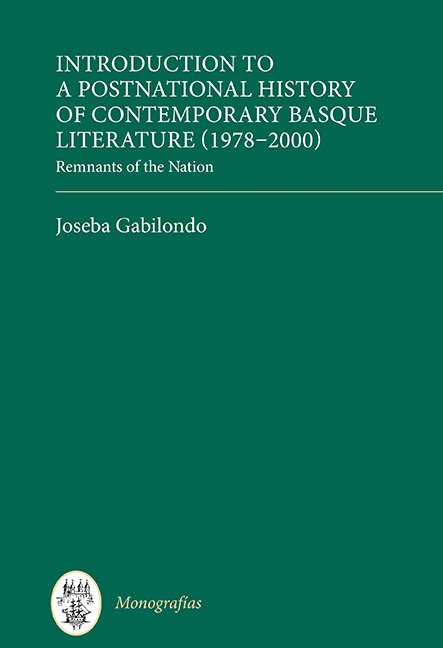 Introduction to a Postnational History of Contemporary Basque Literature (1978–2000)
Introduction to a Postnational History of Contemporary Basque Literature (1978–2000) Book contents
- Frontmatter
- Contents
- Preface and Notes on the Translation
- Acknowledgements
- I Postnational Theory and History
- II Writing the Nation: On Atxaga's Ethiopia and Obabakoak (1978-92)
- 4 Postcolonial and Postnational Literatures: Obabakoak (1988-92)
- 5 On Canon Formation: Ethiopia (1978)
- 6 The Legacy of Modernism: from Ethiopia to Obabakoak
- III After the Nation: Hybrid Postnational Literatures (1992-2000)
- Epilogue: Basque Literatures 2001-17
- Works Cited
- Index
6 - The Legacy of Modernism: from Ethiopia to Obabakoak
from II - Writing the Nation: On Atxaga's Ethiopia and Obabakoak (1978-92)
Published online by Cambridge University Press: 06 September 2019
- Frontmatter
- Contents
- Preface and Notes on the Translation
- Acknowledgements
- I Postnational Theory and History
- II Writing the Nation: On Atxaga's Ethiopia and Obabakoak (1978-92)
- 4 Postcolonial and Postnational Literatures: Obabakoak (1988-92)
- 5 On Canon Formation: Ethiopia (1978)
- 6 The Legacy of Modernism: from Ethiopia to Obabakoak
- III After the Nation: Hybrid Postnational Literatures (1992-2000)
- Epilogue: Basque Literatures 2001-17
- Works Cited
- Index
Summary
To the Reader
Atxaga's Obabakoak elicits several questions regarding the phenomenon and event that this novel has become in the Basque Country – a local development that is not as well known as its later Spanish and global aftermath. I will here advance three questions in order to understand this phenomenon in its original historical and cultural Basque context. The first question is related to the success of Obabakoak: why such an unprecedented success among Basque readers? What do people find in this book? So far there is no reliable information to know how many people have read the book, yet it can be safely stated that many have, at least, purchased it, as the publishing house Erein can confirm (around 40,000 copies sold). The second question is related to the extension of the Chronotope represented by Obabakoak. Unlike any prior Basque book, this novel has opened up the literary Basque imagination far and wide, both in the history or chronos it explores and in the geography or topos it travels and represents. In Obabakoak, time spans from the Middle Ages to our days, while making a long pause in the modernist period of the early twentieth century. As to space, Obabakoak also extends from China to Hamburg, with halts in places such as the Amazon and Iraq. The third question involves the style of the novel. Why does Obabakoak resort to a conspicuous diversification of styles? In the novel, the reader finds medieval mythical tales just as well as colonial nihilist stories. The stylistic question can be recast in various ways: what are the literary models that Obabakoak follows? In which literary trend or movement can we situate Obabakoak, both historically and geographically? The question about style, model, or trend is not simply formal; it is an irreplaceable tool for the cultural and historical analysis of Obabakoak and, more generally, of the Basque literature that emerged in the 1980s and early 1990s.
- Type
- Chapter
- Information
- Introduction to a Postnational History of Contemporary Basque Literature (1978–2000)Remnants of the Nation, pp. 115 - 154Publisher: Boydell & BrewerPrint publication year: 2019
